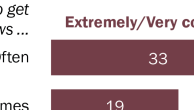This analysis builds from a study produced by Pew Research Center in 2009, which examined the makeup of the Washington press corps from 1985 through 2009, chronicling the rise of niche and foreign press, as well as the decline of legacy media in Washington over the course of several decades. This study examines the changes in that makeup since 2009 and adds a study of coverage in newspapers with and without a D.C.-based correspondent.
The report draws upon several distinct methodologies and data sets.
The accounting of the journalists and news organizations with a presence in Washington draws upon multiple data sources, primarily, the four Senate galleries, which accredit news staff from print, broadcast, digital, news agency and other kinds of organizations to cover Congress. In addition, researchers studied and tabulated the listings compiled by Hudson’s Washington News Media Contacts Directory, and reported numbers supplied by the Regional Reporters Association and the U.S. State Department Foreign Press Center in Washington.
The content analysis of national government coverage in local newspapers collected and analyzed material from eight different local daily newspapers, each differing by region, state, ownership, and stratified by circulation tier. Four of the papers were staffed by a D.C.-based reporter, while the other four were not. The study included stories published between Feb. 1 and May 31, 2015, omitting weeks in which Congress was not in session. A total of 624 newspaper editions were studied for a total of 2,794 stories.
In addition, direct interviews with current and former members of the Washington press corps were conducted, as well as with individual staff who work for the institutions that provided data. A total of 21 interviews were conducted in person and on the phone.
Database and directory secondary analysis
There is no single definitive, comprehensive database that lists every news organization and every journalist based in Washington, D.C. However, there are sources – mainly directories, accreditation lists and membership lists – available that do list a significant percentage of those journalists and news organizations based in the nation’s capital. This report draws chiefly upon two sources: The Senate galleries and Hudson’s.
Each reflects a different collection of data about news organizations. Like most organizational directories, the accuracy for any one year is subject to omission, human error and/or inaccurate or incomplete reporting on the part of the news organizations themselves. But each source, over time, provides trends about those particular measures.
Senate Galleries
The four Senate galleries publish lists of the organizations and individuals accredited to cover Congress (the lists are compiled and published for every Congress in the Congressional Directory and have been since 1888). The four galleries – entitled Press, Periodical, Radio and Television, and Photographers – are generally updated and published every two years.
This report draws primarily upon information found in the Press Gallery (the most recent edition was published in February 2014), and continues trends established in Pew Research Center’s 2009 report. The Press Gallery is of particular interest due to the fact that it houses the main share of journalists and publishers that serve a local audience (daily newspapers), and also because it is where much of the change has occurred in recent years as new entrants, such as digital news startups, begin to replace some legacy news producers in the ranks.
Some limited information was also included from the other Senate galleries, though not all galleries operate according to the same accreditation rules; the Photographers Gallery does not have a Washington-area residency requirement. And the makeup of the galleries may differ one to the next: The Radio and Television Gallery is quite large in size, but includes technical staff such as producers and videographers, rather than just reporters.
News organizations sometimes accredit every member of their Washington staff, including support staff. Thus the number of congressional accreditations for a news organization sometimes exceeds the number of journalists it employs and the number of actual reporters on the beat for any one year. Still, the changes year to year reveal accreditation patterns over time and provide one way to identify and track these trends.
Analysis of the gallery data was conducted as follows:
To tabulate the total number of journalists accredited to each of the four galleries, researchers downloaded the lists found on the Congressional Directory page of the U.S. Government Publishing Office website. The lists were converted into CSV files, with a second researcher checking every 50th entry to ensure the data were transferred correctly. The totals were then summed, with the individual journalist name used as the unit of measurement.
Each Senate gallery lists journalists’ names and affiliated news organizations. For the Senate Press Gallery analysis researchers took further steps to classify every journalist listed into the types of news outlets represented. Five categories were used – three that matched the categories used in the 2009 report, and two new categories.
The three from 2009 were: U.S. mainstream wire services (The Associated Press and Reuters); U.S. mainstream daily newspapers (individual papers such as The New York Times and corporate owners such as Gannett); and U.S. niche outlets (such as Roll Call).
The two new categories were as follows:
Broad-interest digital news outlets (domestic outlets such as The Huffington Post), which began establishing a presence in Washington in recent years. Researchers also identified journalists working for a niche outlet that was a digital-native publication. (An outlet is considered “digital-native” if it was launched on the web, and the internet is its primary distribution platform.) This allowed us to calculate the total number of digital-native journalists whether with broad interest or niche outlets.
Foreign Journalists: The number of foreign journalists was drawn from the Press Gallery list as well. The 2009 Pew Research Center report drew primarily upon the Foreign Press Centers for data on the number of foreign correspondents in Washington. While this report utilizes data from that source as well, the primary source used is the Senate Press Gallery – which allowed us to more easily compare the number of foreign journalists in Washington to the number of journalists from other kinds of organizations, such as daily newspapers. These two agencies credential journalists using different criteria, but both help give a sense of the trends. (Following the method used in 2009, news organizations focusing on a niche subject such as energy or finance, yet also had multiple headquarters around the world including in Washington, were categorized as domestic.)
Every name and outlet in the Press Gallery list was categorized by a research staff member, and each entry was reviewed by a senior staff member. Each outlet was researched individually to determine its appropriate category. When disagreements arose among staff members or when an outlet’s origin or status was unclear, someone on the research staff contacted the publisher of the outlet directly via telephone or email for clarification.
For the other Senate galleries, information about the number of journalists working for a specific outlet or group of outlets was tabulated but not classified into categories in the same way that the Press Gallery was for this report.
Hudson’s Washington News Media Contacts Directory
Published annually since 1968, the Hudson’s directory lists news organizations with a presence in Washington by category (e.g. newspapers, radio, television, specialty or niche publications, news services, etc.) and also lists individual journalists working at each organization. The data are available both in a print edition and in an online database. In order to work with the most current information, researchers collected the information provided in the database and saved it in a CSV file for further analysis.
Data tallied from the 2015 edition was used to update several data points found in the 2009 report, which itself relied upon data from the 1985, 2000, 2004 and 2008 editions, including the number of daily newspapers with their own bureau, the number of papers served by a corporate parent’s Washington bureau, the number of foreign publications with a Washington bureau, and the number of local TV stations served by the Washington bureau of a corporate parent.
Content analysis
This report also examined news media coverage of the federal government in eight newspapers from Feb. 1 to May 31, 2015, for the weeks Congress was in session. That resulted in 13 weeks of content with four weeks omitted because Congress was not in session. The four weeks omitted were as follows:
- Feb. 15-20
- March 29-April 3
- April 5-10
- May 24-29
In all, a total of 624 newspaper editions were coded over 78 days and included 2,794 stories. Newspapers were collected through e-editions that were identical to the print versions. Human coders examined the entirety of each paper to determine which stories were relevant and would be included in the study.
The study consisted of newspaper editions that were published six days a week (Sunday through Friday).
Sample design
Eight newspapers were selected for this project: four that had bureaus based in Washington, D.C., and four that did not. Papers were selected so that each group would have a similar mix of papers according to circulation size, geographic location and ownership. Accessibility to online versions of the papers was also considered.
Both sets of newspapers had one paper from each of the following regions as defined by the U.S. Census Bureau: Northeast, South, Midwest and West. Each group also had one paper with a circulation size of over 200,000 according to recent data by the Alliance of Audited Media, two papers with circulations between 100,000 and 200,000, and one paper with a circulation less than 100,000.
The newspapers included in the study were as follows:
Newspapers with a D.C. correspondent
- Albuquerque Journal (Owned by Journal Publishing Company)
- The Buffalo News (owned by Berkshire Hathaway)
- Milwaukee Journal Sentinel (owned by Journal Media Group)
- The Oklahoman (owned by OPUBCO Communications)
Newspapers without a D.C. correspondent
- The Providence Journal (Owned by New Media Investment Group)
- San Jose Mercury News (Owned by MediaNews Group)
- The Toledo Blade (Owned by Block Communications)
- The Virginian-Pilot (owned by Landmark Media Enterprises)
Content capture
For each paper, researchers examined e-editions that were exact digital copies of the print versions.
Most of the e-editions were accessed using the PressDisplay web service. The exceptions were San Jose Mercury News, The Toledo Blade and The Virginian-Pilot because each of those papers had e-edition archives available on their own websites.
To ensure all relevant articles produced by the specific D.C. correspondents were included, supplementary searches were conducted. These included keyword searches for the journalists’ names in both the Lexis database, and keyword searches in the archives available on each of the newspapers’ own websites.
Story selection
The unit of analysis for this study was the story.
For all the newspapers collected, researchers examined every article to determine if the story fit the criteria for inclusion in this study. News stories were included if 25% or more of the story was about national governing or policy. These included subjects such as:
- National legislation
- Executive actions taken by the White House
- Congressional affairs
- Federal agencies
- State or municipal governments if they are responding to federal laws or actions
- Supreme Court rulings
- U.S. foreign affairs (only if Congress or the U.S. federal government was involved)
Several types of stories were specifically excluded. Among those were stories about the federal government that were not about policy or legislation. This included stories about subjects such as ceremonies and state dinners. Op-eds and editorials were excluded, as were letters to the editor. Lists of votes were skipped if there was no other reporting included. Stories that were purely focused on the horse-race aspect of a political campaign were excluded as well.
Story codes
The data in this study were created by a team of four experienced coders under supervision by a senior researcher. The following variables were used:
- Dateline: The city or location that is listed as the dateline for the story.
- Author’s organization: Determines which organization produced the content.
- Sources cited: Denotes whether a person or group is quoted, interviewed or clearly labeled as the source of factual information in a story.
- Local mention: Denotes if the story includes information related to the local area (city/state/region) where the newspaper is based.
- Local impact: Denotes if the story includes information about how the issue discussed relates to public life in the local area/state/region where the newspaper is located.
- Geographic focus: This variable concerns the geographic area to which the content of the story is relevant in relation to the location of the news source.
- Area of government: Indicates the part of government that is the subject of the story, where the option chosen was the best fit.
- Word Count: Designates the word count of each story.
- Placement: Designates where stories are located within a publication.
- Primary impact: Determines the group, organization or person whose circumstances will somehow be changed by the action that is the focus of the story.
- Trigger: Designates the action, event or editorial decision that makes this news, thus triggering its publication.
Categorization of story authorship
Throughout the report, the authorships of articles are generally classified in four categories:
- stories produced by D.C.-based correspondents
- stories produced by other staff not based in D.C.
- stories produced by any wire service (independent such as The Associated Press or wires services owned by parent media companies such as Journal Wire Reports or Blade News Services)
- stories produced by other national media outlets not directly associated with the newspaper (such as The New York Times or The Washington Post)
Some stories had a combination of authors from different organizations or classifications. In those cases, stories were classified into a single group with the following rules:
- Stories that were produced by multiple reporters with at least one of them being a staff D.C. correspondent were included in the “produced by a staff D.C. correspondent” category.
- Stories that were produced by a combination of staff members and outside organizations were included in the “produced by staff not located in D.C.” category.
Datelines for each story were recorded as listed in the paper, unless an article had no dateline listed at all. In those instances, the home city of the paper (or of the other media outlet that produced the story) was recorded as the dateline location.
Intercoder testing
Each coder trained with a senior researcher for approximately two weeks to learn the codebook.
In order to demonstrate the validity of the coding rules that were specific for this project, intercoder testing was conducted on all variables. The testing consisted of two stages. Before the coding began, each member of the coding team was given the same 40 randomly selected stories to code. Then, after the coding was completed, 102 randomly selected stories were coded by two different coders. In total, 142 stories were coded by more than one person for comparison.
The percent of agreement on each variable for the two stages combined was:
- Dateline: 92%
- Author’s organization: 92%
- Sources cited (all 20 sources combined): 96%
- Local mention: 90%
- Local impact: 89%
- Geographic focus: 89%
- Area of government: 90%
- Word Count (+- 10 words): 98%
- Placement: 99%
- Primary impact: 86%
- Trigger: 89%
- Topic: 87%
In addition, coders had to determine whether stories should be included or excluded from the study according to the coding rules. Researchers tested the reliability of this process in two stages. Before coding, each member of the team was given the same 30 stories to code for inclusion or exclusion. After the coding was completed, two coders examined 25 newspaper editions (or 124 stories) to see if each story should be included or excluded. Agreement for these 154 stories was 89%.
Direct interviews
The findings in this report were reinforced and provided context by a total of 21 one-on-one interviews conducted by Pew Research Center staff. Most of the sources reside or work in the Washington, D.C., area.
A total of five out of the 21 interviews were conducted in person and generally lasted between 30 and 60 minutes. The remainder were conducted by phone and generally lasted between 10 and 45 minutes.
Interview subjects included current and former Washington-based reporters and editors working for print, broadcast and online publications in the capital. Also interviewed were staff members of the Press, Radio and Television, Periodical and Press Photographers galleries, as well as a former Senate staffer, and heads of nonprofit and for-profit organizations that track and list Washington-based journalists.
Interviews were recorded, transcribed, and organized according to themes that emerged in the text.




